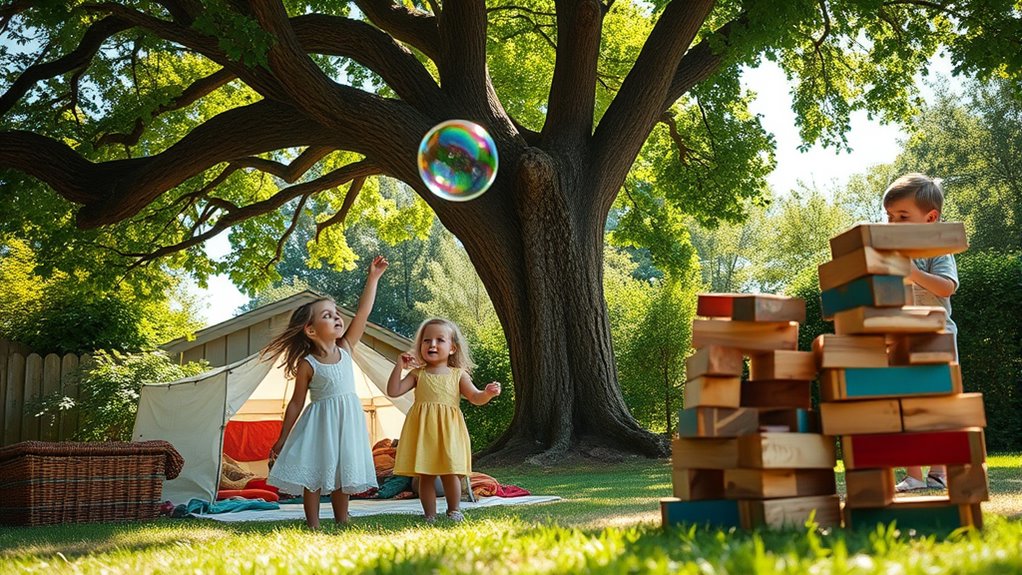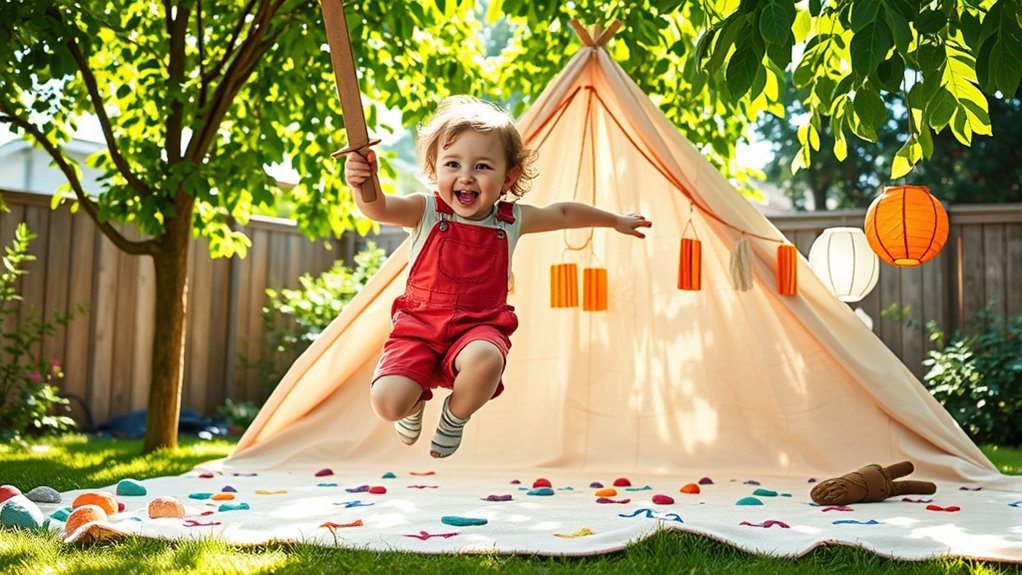Creative play allows you to rediscover childhood imagination by encouraging sensory exploration, emotional expression, and social skills. When you engage in arts, crafts, or pretend scenarios, you help develop problem-solving, confidence, and emotional intelligence. These activities boost curiosity about the world and foster personal growth. By embracing creative play, you nurture your child’s development in a joyful and meaningful way. Keep exploring to uncover more ways this playful approach can open your child’s full potential.
Key Takeaways
- Creative play revives childhood imagination by encouraging open-ended activities that foster artistic expression and sensory exploration.
- It helps children develop cognitive skills like problem-solving and fine motor coordination through hands-on artistic engagement.
- Engaging in creative play enhances emotional intelligence by providing outlets for feelings and building self-awareness.
- Collaborative creative activities teach social skills such as sharing, cooperation, and empathy among peers.
- Rediscovering childhood imagination through creative play nurtures lifelong curiosity, confidence, and a sense of personal identity.

Have you ever wondered how creative play shapes a child’s development? When you encourage a child to engage in imaginative activities, you’re opening the door to a world where artistic expression and sensory exploration flourish. These experiences aren’t just about fun; they form the foundation for essential skills that last a lifetime. Through creative play, children learn to express their feelings and ideas visually, verbally, or through movement, strengthening their artistic expression. Whether they’re painting, drawing, or acting out stories, they develop a sense of identity and confidence in their unique voice. At the same time, sensory exploration plays an important role. As kids manipulate different textures, colors, and materials, they build a richer understanding of their environment. Touching, smelling, listening, and observing help sharpen their senses and foster curiosity about the world around them.
Creative play nurtures expression, sensory skills, and confidence, building a foundation for lifelong learning and emotional growth.
When you set up opportunities for creative play, you’re not just providing entertainment—you’re nurturing a child’s cognitive and emotional growth. For instance, giving children access to various art supplies like clay, paint, or fabric invites them to experiment freely. This hands-on interaction stimulates their sensory pathways, helping them process information more effectively. As they combine colors, blend textures, or create patterns, they’re practicing problem-solving and fine motor skills, all while enjoying the satisfaction of making something personal. Furthermore, engaging in artistic expression during play encourages children to communicate non-verbally, offering an outlet for feelings they might not yet have words for. This process fosters emotional intelligence and resilience, as kids learn to navigate their inner worlds through creative activities.
Creative play also promotes social skills when done with others. Sharing art supplies, collaborating on a pretend scenario, or taking turns in a role-playing game teaches children cooperation and empathy. These interactions reinforce the importance of listening, negotiating, and respecting others’ ideas, which are critical skills for their overall development. Additionally, creative play provides a safe space for children to experiment with different roles and scenarios, helping them understand diverse perspectives. This exploration nurtures imagination and flexibility, preparing them to adapt to new challenges with confidence.
In essence, the power of creative play lies in its ability to blend artistic expression with sensory exploration, forming a rich tapestry of developmental benefits. You hold the key to revealing a child’s potential by creating environments where imagination can soar, textures can be felt, and ideas can be expressed freely. When you prioritize creative activities, you’re helping children build a strong foundation for lifelong learning, emotional health, and self-discovery.
Frequently Asked Questions
How Does Creative Play Benefit Adult Mental Health?
Creative play boosts your mental health by helping you stay present through mindfulness practices, reducing stress and anxiety. It encourages emotional resilience, making it easier to handle life’s challenges. When you engage in playful activities, you activate your imagination and release endorphins, which improve mood. This playful approach fosters a sense of freedom and joy, ultimately strengthening your mental well-being and helping you develop healthier coping strategies.
What Are Some Inexpensive Materials for Imaginative Play?
Think of your home as a treasure chest for creative play. You can use DIY crafts and recycled materials like cardboard boxes, bottle caps, and fabric scraps to spark imagination. These inexpensive materials transform into anything you envision—castles, spacecraft, or puppet theaters. Not only do they save money, but they also turn everyday items into magical tools for childhood-like adventures, helping you reconnect with your inner child.
How Can Parents Encourage Creativity Without Pressure?
You can encourage your child’s creativity by engaging in imaginative storytelling together and offering open-ended activities that spark their imagination. Avoid pressure by allowing them to lead play and explore freely, providing materials like old clothes, craft supplies, or natural objects. Celebrate their ideas and efforts, fostering confidence. Your support creates a safe space where their imagination flourishes, making playtime both fun and enriching without feeling like a test.
What Are Common Obstacles to Engaging in Creative Play?
You might face obstacles like concerns over playground safety and excessive screen time, which can limit spontaneous creative play. Worrying about injuries may make you hesitant to let your kids explore freely, while too much screen time can dull their imagination. To overcome these, set safe boundaries at the playground and encourage outdoor activities that foster creativity. Balancing safety and free play helps your children develop their imagination naturally.
How Does Creative Play Influence Problem-Solving Skills?
When you engage in creative play, like building a new game with your kids, you boost imagination development and cognitive flexibility. This process helps you see problems from different angles and come up with innovative solutions. For example, a child inventing a story to solve a conflict demonstrates how creative play enhances problem-solving skills by encouraging flexible thinking and imagination, making you more adaptable in tackling real-life challenges.
Conclusion
Don’t let the busyness of life steal your child’s imagination. Embrace creative play, knowing it’s not just fun—it’s essential for their growth and happiness. Even when responsibilities pile up, taking a moment to play can reconnect you with childhood wonder and strengthen your bond. Remember, nurturing their imagination today builds confident, creative adults tomorrow. So, make space for those simple, joyful moments—you’ll be glad you did.









